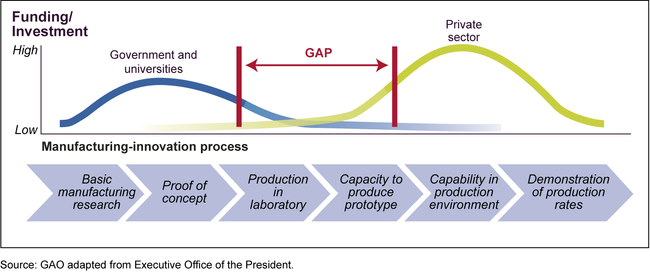Nanomanufacturing and U.S. Competitiveness: Challenges and Opportunities
Highlights
What GAO Found
Forum participants described nanomanufacturing as an emerging set of developments that will become a global megatrend: a technological revolution that is now in its formative phases but that many knowledgeable persons—in science, business, and government—expect to burgeon in the years ahead, bringing new opportunities, “disruptive innovation,” jobs creation, and diverse societal benefits. They said that the United States likely leads in sponsorship and overall quality of nanotechnology R&D today as well as some areas of nanomanufacturing—for example, nanotherapeutic drug development and the design of semiconductor devices. But they cautioned that the United States faces global-scale competition and is struggling to compete in some industry areas (notably, advanced batteries). Challenges facing U.S. nanomanufacturing include (1) a key U.S. funding gap in the middle stages of the manufacturing-innovation process, as illustrated below; (2) lack of commercial or environmental, safety, and health (EHS) standards; (3) lack of a U.S. vision for nanomanufacturing; (4) extensive prior offshoring in some industries, which may have had unintended consequences; and (5) threats to U.S. intellectual property.
Funding/Investment Gap in the U.S. Manufacturing-Innovation Process

Key actions identified by our experts to enhance U.S. nanomanufacturing competitiveness include one or more of the following: (1) strengthen U.S. innovation by updating current innovation-related policies and programs, (2) promote U.S. innovation in manufacturing through public-private partnerships, and (3) design a strategy for attaining a holistic vision for U.S. nanomanufacturing.
Key policy issues identified by our experts include the development of international commercial nanomanufacturing standards, the need to maintain support for basic research and development in nanotechnology, and the development of a revitalized, integrative, and collaborative approach to EHS issues.
Why GAO Did This Study
Nanotechnology has been defined as the control or restructuring of matter at the atomic and molecular levels in the size range of about 1–100 nanometers (nm); 100 nm is about 1/1000th the width of a hair.
The U.S. National Nanotechnology Initiative (NNI), begun in 2001 and focusing primarily on R&D, represents a cumulative investment of almost $20 billion, including the request for fiscal year 2014. As research continues and other nations increasingly invest in R&D, nanotechnology is moving from the laboratory to commercial markets, mass manufacturing, and the global marketplace. Today, burgeoning markets and nanomanufacturing activities are increasingly competitive in a global context—and the potential EHS effects of nanomanufacturing remain largely unknown.
GAO was asked to testify on challenges to U.S. competitiveness in nanomanufacturing and related issues. Our statement is based on GAO's earlier report on the Forum on Nano-manufacturing, which was convened by the Comptroller General of the United States in July 2013 (GAO 2014; also referred to as GAO-14-181SP ). That report reflects forum discussions as well as four expert-based profiles of nano-industry areas, which GAO prepared prior to the forum and which are appended to the earlier report.
For more information, contact Timothy Persons, Chief Scientist, at (202) 512-6412 or personst@gao.gov.
